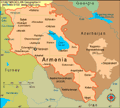Armenia
Facts & Figures

-
President: Serzh Sarkisyan (2008)
Prime Minister: Hovik Abrahamyan (2014)
Land area: 11,506 sq mi (29,800 sq km); total area: 11,506 sq mi (29,800 sq km)
Population (2014 est.): 3,060,631 (growth rate: -0.13%); birth rate: 13.92/1000; infant mortality rate: 13.97/1000; life expectancy: 74.12
Capital and largest city (2011 est.): Yerevan, 1.116
Other large cities: Vanadzor, 147,400; Gyumri (Leninakan), 125,300; Abovian, 59,300
Monetary unit: Dram
National Name: Hayastani Hanrapetut'yun
Languages: Armenian (official) 97.9%, Kurdish (spoken by Yezidi minority) 1%, other 1% (2011 est.)
Ethnicity/race: Armenian 98.1%, Yezidi (Kurd) 1.1%, other 0.7% (2011 est.)
Religion: Armenian Apostolic 92.6%, Evangelical 1%, other 2.4%, none 1.1%, unspecified 2.9% (2011 est.)
National Holiday: Independence Day, September 21
Literacy rate: 99.4% (2012 est.)
Economic summary: GDP/PPP (2013 est.): $20.61 billion; per capita $6,300. Real growth rate: 4.6%. Inflation: 6.2%. Unemployment:17.3% (2013 est.). Arable land: 14.47%. Agriculture: fruit (especially grapes), vegetables; livestock. Labor force: 1.394 million; agriculture 44.2%, industry 16.8%, services 39% (2008 est). Industries: diamond processing, metal-cutting machine tools, forging-pressing machines, electric motors, tires, knitted wear, hosiery, shoes, silk fabric, chemicals, trucks, instruments, microelectronics, jewelry manufacturing, software development, food processing, brandy. Natural resources: small deposits of gold, copper, molybdenum, zinc, alumina. Exports: $1.653 billion (2013): diamonds, mineral products, foodstuffs, energy. Imports: $3.459 billion (2013 est.): natural gas, petroleum, tobacco products, foodstuffs, diamonds. Major trading partners: Russia, Belgium, Germany, Iran, U.S., Georgia, Netherlands, Canada, Bulgaria, Switzerland(2012)
Communications: Telephones: main lines in use: 584,000 (2012); mobile cellular: 3.223 (2012). Broadcast media: 2 public TV networks operating alongside more than 40 privately owned TV stations that provide local to near nationwide coverage; major Russian broadcast stations are widely available; subscription cable TV services are available in most regions; Public Radio of Armenia is a national, state-run broadcast network that operates alongside about 20 privately owned radio stations; several major international broadcasters are available (2008). Internet hosts: 194,142 (2012). Internet users: 208,200 (2011).
Transportation: Railways: total: 869 km (2012). Highways: total: 7,705 km (2012). Waterways: n.a. Ports and harbors: none. Airports: 11 (2013).
International disputes: the dispute over the break-away Nagorno-Karabakh region and the Armenian military occupation of surrounding lands in Azerbaijan remains the primary focus of regional instability; residents have evacuated the former Soviet-era small ethnic enclaves in Armenia and Azerbaijan; Turkish authorities have complained that blasting from quarries in Armenia might be damaging the medieval ruins of Ani, on the other side of the Arpacay valley; in 2009, Swiss mediators facilitated an accord reestablishing diplomatic ties between Armenia and Turkey, but neither side has ratified the agreement and the rapprochement effort has faltered; local border forces struggle to control the illegal transit of goods and people across the porous, undemarcated Armenian, Azerbaijani, and Georgian borders; ethnic Armenian groups in the Javakheti region of Georgia seek greater autonomy from the Georgian Government.

